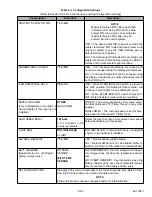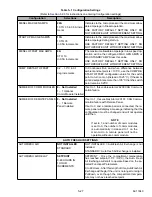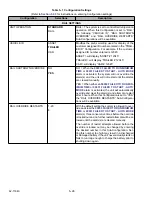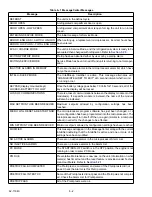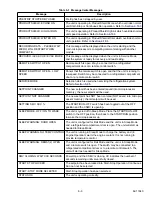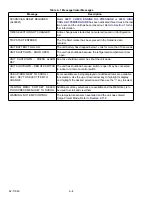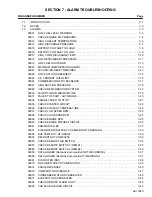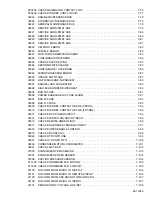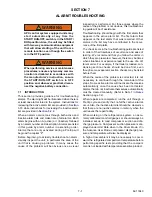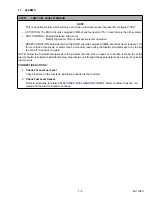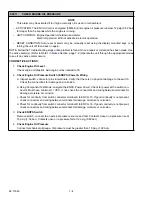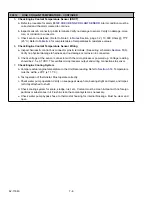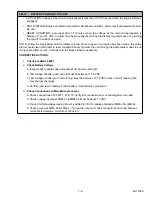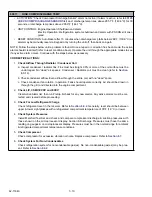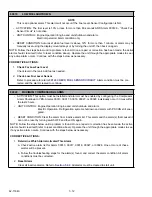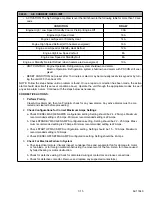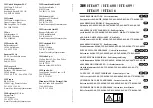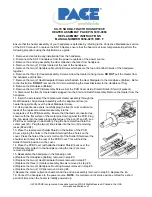
62-11640
7–2
7.2
NOTES
NOTE
Note 1:
The active alarm list may be cleared
when in the Driver Mode or Advanced User
Mode by pressing the CLEAR ALARMS soft
key. That is: the alarm is “cleared” from the
active alarm list and moved to the inactive
alarm list for later review if the condition that
caused the alarm has been corrected. When
Shutdown Alarms are cleared, the unit will
attempt to restart. When non-Shutdown
Alarms are cleared, there will be no notice-
able change in the unit’s operation.
The Inactive Alarm list may be cleared when
in the Technician Mode in the same way.
From the inactive alarm list the technician
has the option to “Clear Inactive” alarms only
or to “Clear All” alarms. Clearing the inactive
alarm list removes the alarm from the sys-
tem. However alarms that have been acti-
vated will remain in the data recorder.
NOTE
Note 2:
The Virtual Tech system may pro-
vide a “signal” voltage when a circuit is not
energized (nominal 3 to 5 volts). This signal
voltage is used by the control system to acti-
vate an alarm message if there is a problem
in the circuit but should not be used for com-
ponent testing. When instructed to test for
voltage, energize the component using
Component Test Mode to ensure the correct
voltage is being read. Refer to
, Also, testing may be performed with-
out the unit starting. To do this, place the
unit in PC Mode before using Component
Test Mode. Refer to
NOTE
Note 3:
Sensors may be tested by taking a
resistance measurement, at the sensor side
of the harness connector, at the sensor loca-
tion. To do this, being careful not to damage
the connector pins, disconnect the sensor
from the harness and measure resistance.
Refer to
for chart of resistances
for different sensors. The interconnecting
wiring may also be tested by checking for
continuity between the harness side of the
connector at the sensor location and the har-
ness side of the connector at the module.
NOTE
Note 4:
The switches, (door/remote, high
pressure, engine oil pressure and defrost
air) may be tested by checking continuity, at
the switch side of the harness connector, at
the switch location. To do this, being careful
not to damage the connector pins, discon-
nect the switch from the harness and check
continuity to determine if the switch is open
or closed. The interconnecting wiring for the
door/remote, engine oil pressure and defrost
air switches may also be tested by checking
for continuity between the harness side of
the connector at the switch location and the
harness side of the connector at the module.
High pressure switch (HPS) interconnecting
wiring may be tested by checking for conti-
nuity between the harness side of the con-
nector at the high pressure switch location
and the PCM or J
−
1 harness connector.
NOTE
Note 5:
Some tests can only be conducted
while the unit is operating. The unit may be
started automatically by placing the SROS in
the Start/Run position.
Summary of Contents for Vector 8500
Page 23: ...62 11640 1 6 1 3 SAFETY DECALS ...
Page 24: ...1 7 62 11640 62 03958 ...
Page 25: ...62 11640 1 8 ...
Page 26: ...1 9 62 11640 ...
Page 27: ...62 11640 1 10 ...
Page 125: ...62 11640 SECTION 6 MESSAGECENTER PARAGRAPH NUMBER Page 6 1 MESSAGECENTER MESSAGES 6 1 ...
Page 321: ......
Page 322: ......

